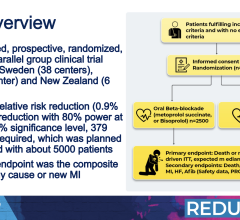September 22, 2014 — According to a new study, patients receiving six months of dual antiplatelet therapy (DAPT) after receiving a second-generation drug-eluting stent (DES) appeared to have similar outcomes to patients who received DAPT for a full year. Findings were reported Sept. 15 at the 2014 Transcatheter Cardiovascular Therapeutics (TCT) scientific symposium. Results of the trial were simultaneously published in the Journal of the American College of Cardiology.
The optimal required duration of DAPT in patients implanted with a second-generation DES is a subject of current controversy, with recent studies suggesting that the currently recommended standard of one year of DAPT may be longer than necessary. The SECURITY trial was a randomized, multicenter, multinational, investigator-driven study that aimed to address the need for prolonged use DAPT following the implantation of second-generation DES for patients without high-risk acute coronary syndromes.
SECURITY was designed to test the non-inferiority of six months of DAPT following second generation DES implantation to 12 months of DAPT. Patients with a diagnosis of stable or unstable angina or documented silent ischemia undergoing revascularization with at least one second-generation DES were eligible for the study. A total of 1,399 patients were randomized, 682 assigned to the six-month and 717 to the 12-month group.
After 12 months, the incidence of the primary endpoint (the composite of cardiac death, myocardial infarction (MI), stroke, definite or probable stent thrombosis, or bleeding academic consortium criteria (BARC) type 3 or 5 bleeding) was 4.5 percent in the six-month group compared to 3.7 percent in the 12-month group. After 24 months, both the six-month and 12-month groups showed similar incidences of cardiac death (0.9 percent vs. 0.8 percent, p=0.925), MI (3.1 percent vs. 2.6 percent, p=0.636), stroke (0.9 percent vs. 0.4 percent, p=0.636), stent thrombosis (0.4 percent vs. 0.4 percent, p=0.951) and BARC 3 or 5 bleeding (0.7 percent vs. 1.1 percent, p=0.496).
The rates of the 12-month secondary endpoint (composite of cardiac death, spontaneous MI, stroke, definite or probable stent thrombosis, or BARC type 2, 3 or 5 bleeding at 12 and 24 months) were also similar among the six-month DAPT and 12 month DAPT groups. At 12 months, the incidence of the secondary composite endpoint was 5.3 percent in the six-month group compared to 4 percent in the 12-month group. In the year that followed, both groups had lower incidences of secondary composite endpoints (1.5 percent and 2.2 percent, respectively).
A multivariable analysis found that patient age of 75 years or older, stent type used, mean number of stents implanted, mean stent length, and mean stent size as significant independent predictors of the primary endpoint.
“Six-months of DAPT appeared to be non-inferior to a 12-month regimen in patients undergoing PCI with a second generation DES regarding the primary composite endpoint of cardiac death, MI, stroke, definite or probable stent thrombosis, or BARC type 3 or 5 bleeding at 12 months of clinical follow-up,” said lead investigator Antonio Colombo, M.D. Colombo is the director, Cardiac Catheterization Laboratory of MO GVM Centro Cuore Columbus/San Raffaele Hospital in Milan, Italy.
“Additionally, the six-month DAPT group appeared to be non-inferior to the 12-month group regarding the incidence of the secondary composite endpoints defined by the study protocol,” he said.
The SECURITY trial was funded by grants from Medtronic and Terumo. Colombo reported being a minor shareholder of Direct Flow Inc.
For more information: www.crf.org and www.tctconference.com


 April 11, 2024
April 11, 2024 








